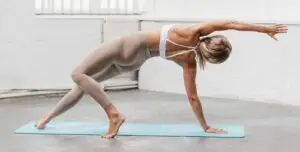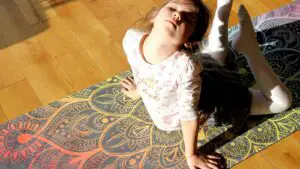Performing hip opening yoga postures can be very beneficial for the release of tension in this region of the body. We rely so much on our hips for example for walking, sitting, running, or dancing.
If there are hinderances in the hips, it makes it challenging to function in these standard ways. Practicing a variety of passive and dynamic yoga hip openers can generate the desired physical release.
Hip openers in yoga serve another important function, too. The hip and pelvic area of the body is associated with Sacral (the Second) Chakra.
“Chakra” in Sanskrit means “wheel” or “disk” and refers to the “energy centers” in our body. There are seven energy centers /chakras in human body. There is an energy line that runs from the base of the spine through the crown of the head, which connects them all. The Second Chakra, or Swadhisthana in Sanskrit, is situated in the lower abdominal region. If you place your hand just below your belly button, this is the area related to the second chakra energy center.
The color attributed to the Second Chakra is orange and the element is water. This space regulates our general emotions like sadness, worry, love, joy, and happiness.
It is also associated with the creative mind and the reproductive system. When this area is open and running efficiently, these functions flow easily and are in balance. If, though, this energy center becomes blocked, it becomes less fluid. You may experience stagnant or stuck emotions or even overwhelming emotional reactions to things. It is important, therefore, to bring balance back to the Second Chakra. Performing hip openers helps to clear the energy blockages for enhanced functioning.
Yoga Hip Openers
Perform these hip opening yoga poses as a sequence on one side first. They are designed to bring awareness to the hip-opening function, but also the energy release sometimes needed in this energy center. When complete, you will shift your focus to the other leg.
Deep Lunge
Start this pose on your hands and knees. Extend your right leg back behind you to experience a full length in this limb. Then step your right foot to the top of the mat. Keep your hands on the inside of the foot. Gently dip your hip forward and downward to feel the hip release in the left leg. This will manifest as a lengthening sensation in your left hip flexor, a part of the body that tends to hold a lot of tension.
You will also feel a hip stretch in the right inner thigh area. You can remain on your hands in this position, but if you’d like to take this further, place your elbows on the floor (if you are unable to reach the ground with your elbows, use a stack of yoga blocks instead). By lowering your body downward in this fashion, you will intensify the release in your right hip. To make this pose even more active, lift your left knee off the floor; this will engage the quadricep. Imagine your thigh bone lifting upward toward the ceiling. Hold your posture for 10 slow, deep breaths.
Deep Lunge Variation
To activate more hip release in your right leg, rise back up onto your hands from the first deep lunge position. Place your right hand on the inside of your bent right leg and gently push outward. (You will need to roll onto the outside edge of your right foot to manipulate this pose.) Your upper body can lean away in the opposite direction. Hold for 10 slow and long breaths. Be mindful of the sensation generated in these hip releases. With the nuanced postures, you can target minute areas in the hips, thighs, and hip flexors for effective release.
Half Splits
From your deep lunge position, slowly shift your hips back until your left hip is aligned over your left knee. Your right leg will automatically extend from its bent position. Brace yourself by keeping your hands (or fingertips) on the floor. Maintain a good length in your spine, too. You will notice a lengthening in the right hamstring, but emphasize the movement of your hips back. This will stimulate more tension release in your hips and glutes. Hold your posture for 10 slow deep breaths.
Eye of the Needle Pose (Sucirandhrasana)
This is a wonderful yoga posture if you have tight hips and muscle tension in your glutes, too. It is accessible to any level of yoga practitioner, so if you want to improve your hip mobility, try this posture. Sometimes it is referred to as Reclining Pigeon Pose (Supta Kapotasana). It is an alternative to the hip opening posture Pigeon Pose, which can potentially cause stress to one’s knee and ankle joints.
Start the Eye of the Needle Pose by lying on your back. Bend your knees with your feet planted on the floor. Cross your right ankle over your left thigh. Your right knee will point toward the right side of the room. Flex this foot; it keeps the leg and hip stable as you move into this posture. Pause to notice if this is creating a sensation in your outer right hip. If so, you are welcome to hold this posture allowing the tension in the hip area to release. If the sensation is mild, you can move deeper into the position.
While flexing your left foot, slowly lift it off the floor. This will guide your crossed leg toward your torso. Continue to observe the sensations around your inner thigh, outer hip, and glutes. Only move your limbs to the spot where the stretch is not too deep.
The idea is to allow for the release of tension; if the sensation is too intense, this may create more stress in this sensitive region of the body.
To hold the posture, thread your left arm through the opening between your legs. Clasp both hands around your right shin or hamstring. This is why it is called “Eye of the Needle Pose.” Your arm through the opening resembles the thread going through the eye of a needle. Once you have found the proper level of sensation and intensity on this side, hold the position for ten slow breaths. This will allow for an adequate release of tightness that tends to build up.
Not only does physical tension arise in this area of the body, but energetically, emotional stress tends to store in your hips. The first, second, and third Chakras are related to the hip region.
Feelings such as joy, stability, strength, creativity, and movement are components of these lower Chakras. If the hips develop tension, essentially, there is a blockage of these feelings; they do not flow as naturally as intended. Hip release, therefore, is essential for clearing these passages.
Happy Baby Pose (Ananda Balasana)

Another hip-opening yoga posture that can be practiced by any yogi is Happy Baby Pose. Begin the posture by lying on your back on your yoga mat. Hug both knees toward your torso. Hold onto your shins in this position. Separate your knees until you experience a gentle stretch in your inner thighs. If this is enough sensation, hold your posture here.
To go further, grab hold of the bottom of your feet with your hands. Lift them until the soles of your feet face the ceiling. Keep your legs wide, and your knees bent at 90 degrees. Gently press down, so it feels like your knees are coming down toward the floor on either side of you. This, too, will create a deeper stretch in the inner thighs. The posture also positively affects your hips and lower back: regions of the body that hold a lot of tension that limit mobility. Hold this posture for ten slow deep breaths. You may hold steady in this yoga position, or add a gentle rocking movement left and right to encourage more release in the hips.
Closing thoughts
In yoga, there is a wide variety of hip opening postures, just like variety of styles of yoga. This is probably due to the notion that many people have some type of hip issues: pain, discomfort, lack of strength, or mobility.
Functional and recreational activities that you enjoy become difficult to perform: walking, climbing the stairs, rising from a chair, jogging, dancing. Yoga postures, especially hip openers, are designed to release tension, which often causes mental and physical distractions.
Because these are gentle yoga postures, you can practice them everyday. In a short period of time, you will notice that your hips as well a s your low back, inner thighs, and glutes will begin to loosen.
The tight muscles and connective tissues supporting these areas will open up so that you will have much improved mobility. You’ll be dancing and smiling in no time!




